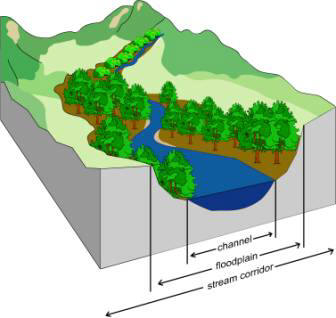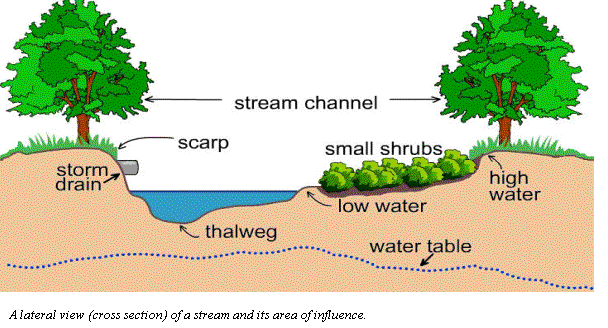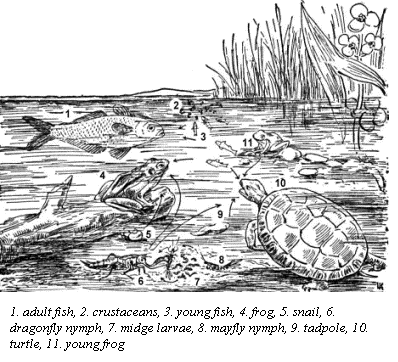|
WHAT IS WETLAND RESTORATION? Restoration
is a process that helps to transform an area that has been impacted by human or
natural activity to an area that can sustain native habitats.
Restoring an area is a long process that requires an understanding of an
area. Learning about the history of
an area and its succession through time, will help determine how to
restore an area. Success can be determined if the ecosystem can recapture
its natural dynamics. It is
not possible to recreate ecosystems exactly, as change is a part of nature.
There are different types
of wetlands that require different strategies.
In this course we will consider stream corridor, open aquatic,
and bay coastal restoration
Stream corridor and open aquatic are fresh water environments while the
bay coastal can range from fresh, brackish, normal marine (35
parts per million) to hypersaline.
There are different ways to approach restoring wetlands depending on the
degradation of that wetland.
Wetland restoration can be expensive. Streams are dependant on nature to
heal past practices, but nature is not always predictable.
Monitoring during and after the restoration is a way to help detect problems
before they become unmanageable. Monitoring usually involves looking at
the biological, geological, hydrological, chemical and physical components of
the creek. |
|
|
STREAM CORRIDOR A
stream corridor refers to rivers and creeks and the adjacent areas that the
water has influence. Water can be
derived from surface (rain) or through aquifers. Some streams run all year (perennial)
or can dry up during portions of the year (ephemeral). The
shape and lateral extend of the stream is dependant on the type of rock, soil
composition, biological growth, and tectonic forces. Creekside vegetation is referred to as the "riparian
zone." It helps protect the
stream channel while providing habitat for organisms
who use the creek. A stream channel is created and maintained by its
energy flow. The erosion in streams
are the result of topography, rock
type, soil cover, climate, ground water, and vegetation. Erosion of the
streambed increases when velocity of the flow increases.
Soil and rock particles are detached when energy is highest.
In low energy areas particles will be deposited.
A stream is always changing |
|
|
|
| A
stream can be a challenge for organisms that live in water.
Flowing water can move mud, sand, and gravel.
The faster the water flows the larger the particles it can move.
As the water slows, particles will settle out and be deposited.
High velocity can scour areas that create pools, which support plankton
(floating organisms), and larger animals like frogs and fish.
Riffles, or areas of gravel help
provide dissolved oxygen as the water
mixes with the atmosphere. Organisms
require dissolved oxygen to live. |
|
|
Trees throughout the stream corridor create many habitats for different organisms. Shade protects aquatic organisms by helping to lower the water temperature during the summer; in the winter the canopy provides protection from the effect of storms. Tree roots assist in reducing erosion within the floodplain. |
|
|
|
|
| When
a stream corridor needs to be restored there are many different techniques.
There are engineering solutions as well as biological solutions.
Below are just a few examples to help you get an understanding of the
complexities. |
|
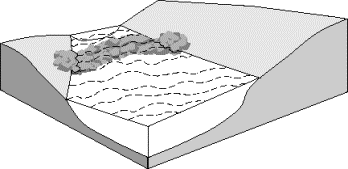 Weirs
or Sills
- A weir or sill can be composed of logs, boulders, or any large
structure placed across a channel to help anchor the stream bank to create a
pool habitat, control bed erosion or collect and retain gravel. Weirs
or Sills
- A weir or sill can be composed of logs, boulders, or any large
structure placed across a channel to help anchor the stream bank to create a
pool habitat, control bed erosion or collect and retain gravel.
|
|
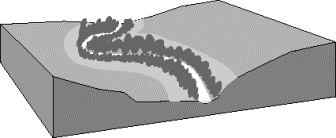 Riparian
Forest buffers -
A buffer helps to preserve a “core”
habitat area. It
usually consists of vegetation that helps to lower water temperature, provides s
source of detritus, nutrients, and can shelter the area from urban pollution. Riparian
Forest buffers -
A buffer helps to preserve a “core”
habitat area. It
usually consists of vegetation that helps to lower water temperature, provides s
source of detritus, nutrients, and can shelter the area from urban pollution.
|
|
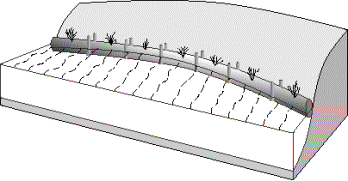 Coconut Fiber Rolls
- These are cylindrical
structures composed of coconut husk fibers bound together with twine to protect
slopes from erosion while trapping sediment to encourage plant growth. Coconut Fiber Rolls
- These are cylindrical
structures composed of coconut husk fibers bound together with twine to protect
slopes from erosion while trapping sediment to encourage plant growth.
|
|
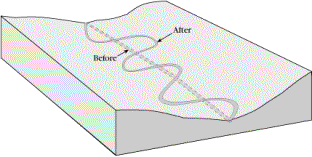 Stream
Meander Restoration - Streams that
are straight do not allow a stable environment for habitat.
A channel can be engineered into a meander. Stream
Meander Restoration - Streams that
are straight do not allow a stable environment for habitat.
A channel can be engineered into a meander.
|
|
|
OPEN
AQUATIC A lake or pond has some different characteristic than
a flowing stream. The restoration
of a fresh water aquatic environment must understand how nature is keeping the
environment in equilibrium in a sometimes-enclosed basin.
In the San Francisco Bay area we have many ponds that are created by
faults. Geologically they are
called sag ponds. The water is from
underwater aquifers that a fault breaches.
It also is supplied with storm water during the rainy season.
There are also lakes in the region, many which have been converted into
reservoirs, so can maintain its level throughout the year through human
engineering. Limnology is a sub
discipline of hydrology, concentrating on the study of fresh waters,
specifically lakes and ponds (both natural and manmade).
This includes the biological, physical and chemical make up of the
environment. Organisms in small ponds are sometimes stressed during
the summer because the demand on the oxygen and nutrients is great as the
Eutrophication
is a natural process in the aging of lakes and some estuaries, but human
activities can greatly accelerate eutrophication by increasing the rate at which
nutrients and organic substances enter aquatic ecosystems from their surrounding
watersheds. Agricultural runoff, urban runoff, leaking septic systems, sewage
discharges, eroded stream banks, and similar sources can increase the flow of
nutrients and organic substances into aquatic systems. These substances can over
stimulate the growth of algae, creating conditions that interfere with the
recreational use of lakes and estuaries, and the health and diversity of
indigenous fish, plant, and animal populations. When restoring the ecosystem of a pond, a full understanding of the organisms that use the pond from small to large must be understood. For example, in the diagram to the right the larger animal an ideal food web is determined. If one of the species is threatened it can upset the balance. If another species is introduced to the area it can also upset the system.
|
|
|
BAY
COASTAL Restoring
areas that are within a coastal bay environment must take into consideration the
varying amount of salt content in the different habitats.
The amount of different habitats varies from area to area, with many
microenvironments. In the next section on San Francisco Estuarine System it goes
through several of those environments.
|
